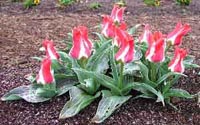Resource Library
Plant of the Week: Tulip, Greigi
The University of Arkansas System Division of Agriculture does not promote, support or recommend plants featured in "Plant of the Week." Please consult your local Extension office for plants suitable for your region.
Plant of the Week
Greigi Tulip
Latin: Tulipa greigii

This spring, the most spectacular bulb in our display garden on campus has been Tulipa greigii, one of the species tulips. I have a love-hate relationship with tulips. I love their beauty in the garden, but I hate the fact that they are so fleeting in both their length of display and intolerant of the conditions our Arkansas gardens provide.
But all gardeners must come to grips with the fleeting nature of beauty and perfection, and perhaps it is this very quest that keeps us hooked on our chosen hobby.
Tulipa greigii is a short, squatty tulip usually under 14 inches tall with long, pointed, blocky flower buds almost 4 inches long. As the sun strikes the plant, the flower buds splay open like a waterlily but close tight as the temperature cools at night. The colors vary from orange-scarlet to cream or yellow. Bicolor selections with broad contrasting swaths are common and seem to be a favorite with tulip breeders.
The foliage is distinctive with a series of brown to maroon stripes running the length of the blade, making this species the easiest to identify of all tulip species. Like other tulips, the leaves die down by the first hot days of summer.
This tulip was the first species tulips introduced into cultivation directly from the wild. It first flowered in European gardens in 1871 from bulbs collected by a German living in the Central Asian town of Taskent, Uzbekistan. This city sits on the edge of the great Central Asian steppe about 150 miles north of the northern Afghan border.
The German, P. L. Graeber and his wife, came into the region shortly after the Russian army wrested control of the sector from their Arab neighbors in 1865. The Russians maintained control over the region until the breakup of the USSR in 1992.
Russia=s move into Asia was a reaction to the footholds that European governments, especially England, were gaining in China through the treaties signed after the Opium Wars. Her move was overland, not by sea as for the Europeans, so intervening territories were gobbled up out of necessity to clear the past to the prize of control of China.
The Greigi Tulip was named by Eduard Regel who was director of the St. Petersburg Botanic Garden, then the center of scientific research in Russia. He named the plant in honor of the president of the Russian Horticultural Society.
In the fine gardens and estates of Europe the cultivated tulip cultivars were suffering a decline in popularity. They were passe, and gardeners lost interest in the gaudy hybrids that the breeders in Holland were mass producing. The arrival of the species tulips coincided with a new gardening fad sweeping Europe, rock gardening. A kind of horticultural elitism developed where wildlings were highly treasured while mundane cultivars were shunned.
The Greigi Tulip and its cultivars are more lasting in our gardens than typical hybrid tulips because they are slow to produce offsets. Each spring as the bulb renews itself, it does not have the numerous daughter bulbs to nourish so the main bulb remains relatively large.
The bulbs should be sited in a location where they get good winter drainage and a good, thorough baking in the summer. Too much moisture during the summer prevents these desert-dwellers from properly curing to ward off the attack of soil-rotting microbes.
By: Gerald Klingaman, retired
Extension Horticulturist - Ornamentals
Extension News - April 19, 2002
The University of Arkansas System Division of Agriculture does not maintain lists of retail outlets where these plants can be purchased. Please check your local nursery or other retail outlets to ask about the availability of these plants for your growing area.